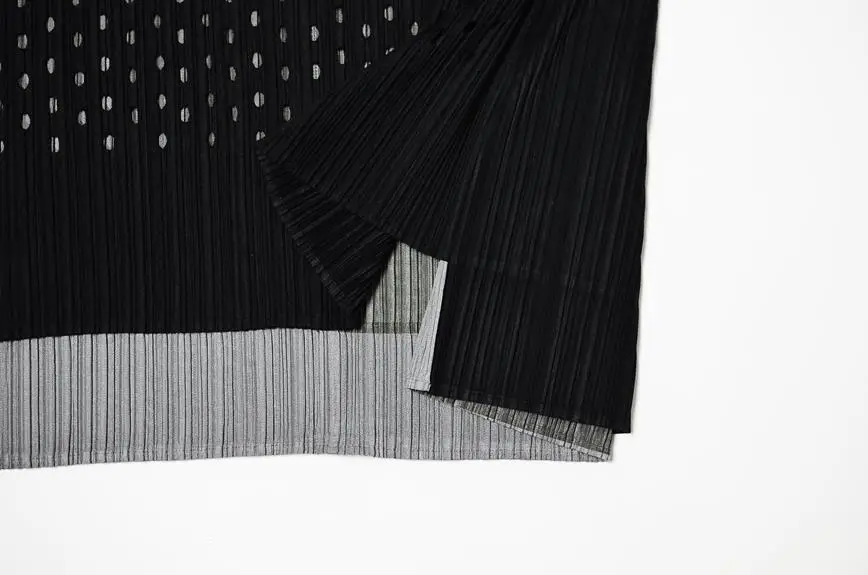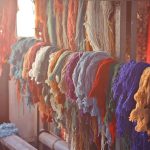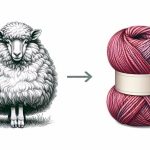Are you pondering whether acrylic fabric is natural or synthetic? Look no further! Acrylic fabric, a fiber known for its affordability and versatility, is often mistaken for a natural material due to its wool-like appearance. However, the truth lies in the production process.
Acrylic fabric is, in fact, a synthetic material derived from acrylonitrile, a petrochemical substance. Understanding the distinction between natural and synthetic fibers is essential for mastering the art of textile knowledge.
In this brief exploration, we will delve into the origins, properties, and environmental impact of acrylic fabric to uncover the truth about its classification as a natural or synthetic material.
Key Takeaways
- Acrylic fabric is a synthetic textile made from acrylonitrile, a petrochemical substance.
- It is produced using the wet spinning method and has improved dyeing process and texture due to technological advancements.
- Acrylic fabric is highly durable, soft to the touch, and has excellent colorfastness.
- However, its production has a significant environmental impact, including carbon emissions, water consumption, and waste generation.
Acrylic Fabric: Origins and Production
Acrylic fabric is a synthetic textile widely produced for its versatility, durability, and affordability. Its historical significance dates back to the mid-20th century when it was developed as an alternative to wool.
The manufacturing process of acrylic fabric involves the polymerization of acrylonitrile, a chemical compound derived from propylene, using a method called wet spinning. This process results in fibers that are then woven into fabric.
The technology advancements in acrylic fabric production have led to improvements in the dyeing process, making the fabric more colorfast and resistant to fading. Additionally, innovations in the manufacturing process have enhanced the softness and texture of acrylic fabric, making it more closely resemble natural fibers like wool.
These advancements have contributed to the popularity of acrylic fabric in various applications, from clothing and upholstery to outdoor textiles. Understanding the historical significance, manufacturing process, and technology advancements of acrylic fabric provides insight into its widespread use and continuous development in the textile industry.
Properties of Acrylic Fabric
When considering the properties of acrylic fabric, you'll find that it offers a combination of lightweight warmth and resistance to wrinkles, making it a popular choice for a variety of textile applications. Acrylic fabric possesses notable properties that make it stand out among other textile materials:
- Durability: Acrylic fabric is highly durable, making it resistant to wear and tear. It can withstand frequent washing and is less prone to fading, stretching, or shrinking compared to natural fibers like wool.
- Softness: Despite its durability, acrylic fabric remains soft to the touch, providing comfort for various garment applications. It can mimic the softness of natural fibers like cashmere, making it an appealing choice for those seeking a luxurious feel without the high maintenance associated with delicate natural fibers.
- Colorfastness: Acrylic fabric has excellent color retention, maintaining vibrant and rich hues over time. This property makes it a preferred choice for vibrant and colorful garments that require long-lasting color durability.
The unique combination of durability, softness, and colorfastness positions acrylic fabric as a versatile and practical material for a wide range of textile products.
Environmental Impact of Acrylic Fabric
You may frequently overlook the environmental impact of acrylic fabric in your purchasing decisions, but it is essential to consider its ecological footprint. When evaluating the environmental sustainability of acrylic fabric, it's crucial to examine factors such as energy consumption, water usage, and the potential for recycling.
| Environmental Impact | Considerations |
|---|---|
| Energy Consumption | Acrylic production requires significant energy input, contributing to carbon emissions. |
| Water Usage | The production of acrylic fabric consumes substantial amounts of water, which can strain local water sources. |
| Recycling Potential | Acrylic fabric is not easily recyclable, leading to increased waste and environmental pollution. |
| Ethical Sourcing | Ensure that acrylic production involves ethical sourcing of raw materials and labor practices to mitigate negative social and environmental impacts. |
When making purchasing decisions, consider the environmental impact of acrylic fabric and seek out alternatives with better environmental sustainability. Look for certifications or labels that indicate ethical sourcing and environmentally friendly production processes. By being mindful of the ecological footprint of the products you choose, you can contribute to a more sustainable and environmentally conscious industry.
Acrylic Fabric: Natural or Synthetic
Considering acrylic fabric as a material choice, you may want to understand whether it's classified as a natural or synthetic fabric, impacting its production and environmental implications. Acrylic fabric is a synthetic fiber made from a polymer called polyacrylonitrile. Here's why this distinction is important:
- Environmental Concerns: Acrylic fabric, being a synthetic fiber, is derived from petrochemicals, making its production process energy-intensive and reliant on non-renewable resources. Additionally, the release of volatile organic compounds during its production raises environmental concerns.
- Natural vs. Synthetic Fibers: Understanding whether acrylic fabric is natural or synthetic is crucial for making informed decisions about its use and impact. Natural fibers like cotton and wool are biodegradable and renewable, while synthetic fibers like acrylic contribute to microplastic pollution and have a higher environmental footprint.
- Production and Environmental Implications: The classification of acrylic fabric as a synthetic material signifies that its production involves chemical processes and may contribute to microplastic shedding during use and washing, posing potential risks to the environment and aquatic life.
The distinction between natural and synthetic fibers is essential for evaluating the environmental implications of acrylic fabric and making sustainable choices in material selection.
Uses and Applications of Acrylic Fabric
Acrylic fabric offers a wide range of uses and applications due to its versatility and durability, making it a popular choice in various industries and consumer products.
In the fashion and textiles industry, acrylic is often used in blends with other fibers to create fabrics that mimic the look and feel of natural materials like wool and cotton. This allows for the creation of more affordable and easy-to-care-for garments that still provide warmth and comfort.
Acrylic's durability makes it a practical choice for outdoor and active wear, as it can withstand frequent washing and exposure to the elements without losing its shape or color.
Additionally, its ability to retain color well makes it a preferred option for vibrant and long-lasting textiles, such as carpets, upholstery, and outdoor furniture.
The versatility of acrylic fabric also extends to industrial applications, where its strength and resistance to chemicals and moisture make it suitable for use in awnings, sails, and outdoor signage.
Frequently Asked Questions
Can Acrylic Fabric Be Composted or Biodegraded at the End of Its Life Cycle?
Yes, acrylic fabric cannot be composted or biodegraded at the end of its life cycle. This has significant environmental impact, challenging sustainability efforts. It's important to consider alternatives for a more eco-friendly choice.
Are There Any Known Health Risks or Concerns Associated With Wearing Acrylic Fabric?
Wearing acrylic fabric may pose health risks like skin irritation and respiratory issues due to its synthetic nature. Its environmental impact includes shedding microplastics when washed, contributing to water pollution.
How Does the Cost of Producing Acrylic Fabric Compare to Other Synthetic or Natural Fabrics?
When comparing the cost of producing acrylic fabric to other synthetic or natural fabrics, it's important to consider the environmental impact as well. Acrylic tends to be less expensive to produce than natural fabrics, but it also has a greater environmental impact.
Are There Any Specific Care Instructions or Special Considerations for Washing and Maintaining Acrylic Fabric?
When washing acrylic fabric, special care is needed. Follow these washing instructions to maintain its quality. Use mild detergent, cold water, and avoid heat. Gently wring out excess water and lay flat to dry.
What Is the Current Market Demand for Acrylic Fabric, and How Does It Compare to Other Types of Fabrics?
Market trends indicate a growing demand for acrylic fabric due to its versatility and affordability. However, concerns about its environmental impact have led to a shift towards sustainable alternatives. Understanding these dynamics is crucial for making informed business decisions.
- How Does Ring Spun Cotton Affect Garment Fit and Shape Retention? - August 13, 2024
- What Are the Challenges in Producing Ring Spun Cotton? - August 13, 2024
- Is Ring Spun Cotton Suitable for Plus-Size Clothing? - August 13, 2024







